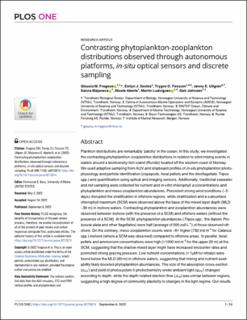| dc.description.abstract | Plankton distributions are remarkably ‘patchy’ in the ocean. In this study, we investigated the contrasting phytoplankton-zooplankton distributions in relation to wind mixing events in waters around a biodiversity-rich island (Runde) located off the western coast of Norway. We used adaptive sampling from AUV and shipboard profiles of in-situ phytoplankton photo-physiology and particle identification (copepods, fecal pellets and the dinoflagellate Tripos spp.) and quantification using optical and imaging sensors. Additionally, traditional seawater and net sampling were collected for nutrient and in-vitro chlorophyll a concentrations and phytoplankton and meso-zooplankton abundances. Persistent strong wind conditions (~5 days) disrupted the stratification in offshore regions, while stratification and a subsurface chlorophyll maximum (SCM) were observed above the base of the mixed layer depth (MLD ~30 m) in inshore waters. Contrasting phytoplankton and zooplankton abundances were observed between inshore (with the presence of a SCM) and offshore waters (without the presence of a SCM). At the SCM, phytoplankton abundances (Tripos spp., the diatom Proboscia alata and other flagellates) were half (average of 200 cell L-1) of those observed offshore. On the contrary, meso-zooplankton counts were ~6× higher (732 ind m-3 for Calanus spp.) inshore (where a SCM was observed) compared to offshore areas. In parallel, fecal pellets and ammonium concentrations were high (>1000 ind m-3 for the upper 20 m) at the SCM, suggesting that the shallow mixed layer might have increased encounter rates and promoted strong grazing pressure. Low nutrient concentrations (< 1μM for nitrate) were found below the MLD (60 m) in offshore waters, suggesting that mixing and nutrient availability likely boosted phytoplankton abundances. The size of the absorption cross-section (σPII’) and yield of photosystem II photochemistry under ambient light (φPII’) changed according to depth, while the depth-related electron flow (JPII) was similar between regions, suggesting a high degree of community plasticity to changes in the light regime. Our results emphasize the importance of using multiple instrumentation, in addition to traditional seawater and net sampling for a holistic understanding of plankton distributions. | |
